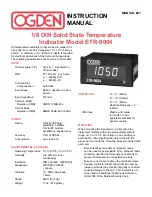
Figure 5 - Threaded Rod
The collector must be raised from the roof surface to allow for rainwater and debris to pass under the collector
and for proper ventilation of the roofing material. There should be at least 1 1/2" of clearance between the roof
surface and the underside of the solar collector.
In selecting mounting hardware and fasteners it is extremely important to avoid galvanic corrosion resulting
from the direct contact of incompatible metals. Use the "Quick-Lock" mounts with stainless steel hardware and
a stainless steel lag or hanger bolt with lock washers and round washers as recommended. In climates subject to
severe winters or high humidity, the use of galvanized fasteners is prohibited.
Preserving the integrity of the roof membrane is the most important roofing consideration. Ensure that all roof
penetrations, required to plumb and mount the solar collector, are properly flashed and sealed in accordance
with standard roofing practices. Tremco's "POLYroof" is the recommended elastomer for sealing roof
penetrations. Henry Co. 204, 208 or 209 roof mastic or Dow Corning Glazing Sealant also are acceptable
sealants.
If the region is subject to high wind or hurricane conditions, additional steps may be required to secure the
collector and mounting hardware to the structural members. In certain areas of the country, local building codes
may require collector wind load testing or prescribe specific mounting procedures. Consult your local building
department.
Collector Plumbing
This installation requires the use of [copper][brass][stainless steel] fittings in the collector loop plumbing. Cast
iron is acceptable for pump volutes and flanges. Couplings rather than unions should be used to join the
collectors to avoid leaks and fluid loss. Use only lead-free solder. Use of 50/50 lead solder is expressly
prohibited. Use of galvanized steel, CPVC, PVC, or any other type of plastic pipe is prohibited. The minimum size
for the "To" and "From" collector piping is 5/8" OD copper.
Piping in new solar installations can be covered with dirt, grease, solder flux or other impurities that over time
affect the quality of the heat transfer fluid (HTF). A thorough cleaning is required before charging the system. A
Содержание AE-Series
Страница 2: ... this page left blank intentionally ...






























